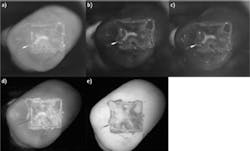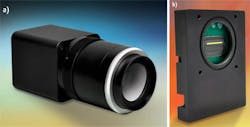OPTICAL COHERENCE TOMOGRAPHY/DENTISTRY: Driving OCT into dentistry
Considering the safety concerns associated with x-rays, newer optical diagnostics are particularly valuable in cases where frequent monitoring improves patient outcomes. Dentistry is one such case, and attendees at the first international Symposium on Optical Coherence Tomography (OCT) in Dentistry (June 20–21, 2013; Tokyo, Japan) came away with substantive evidence of OCT's value and effectiveness as an optical diagnostic for dentistry.
A tireless and passionate advocate of dental OCT, Alireza Sadr, associate professor, Cariology and Operative Dentistry at Tokyo Medical and Dental University (TMDU), organized the symposium. In fact, the event was hosted by TMDU, which has made many important contributions to modern dentistry. Dean of the Faculty of Dentistry Junji Tagami delivered the keynote address. Presentations by university professors and students documented advantages of OCT for dentistry, including:
• Early detection of demineralization and resulting tooth decay
• Identifies active or stable demineralization of enamel
• Safely monitors re-mineralization treatment of caries with multiple images during treatment
• Measures cavity for CAD/CAM design of restoration filling or crowns
• Detects pulp boundary while drilling to avoid irreversible damage that kills the tooth
• Sees underneath composite fillings to detect secondary decay, poor adhesion, and causes of pain
• Measures depth of periodontal pockets, replacing painful mechanical probing
• Detects decay between teeth that x-rays do not find
• Detects cracking to identify sources of pain
• Also useful for oral cancer detection, measurement, and location of legion margins
Further demonstrations of effectiveness
Researchers from the U.S., Canada, Brazil, and Malaysia contributed as well; the lead presentation was by Dan Fried, professor of Preventive and Restorative Dental Sciences at the University of California, San Francisco (UCSF), who documented the value of cross-polarization OCT for quantifying the extent of re-mineralization of caries lesions and to distinguish arrested lesions from active decay. The polarization filter in the cross-blocking case negates the strong reflection off the surface of the tooth, and increases the contrast of the softened zone and the effectiveness of fluoride treatments to re-strengthen it.
UCSF associate professor Cynthia Darling discussed use of Sensors Unlimited's GA1280J indium gallium arsenide (InGaAs) camera for trans-illumination of teeth at 1300 and 1600 nm, and also for cross-polarized reflectance in the 1450 nm water absorbance band. The images drove substantial interest, as the techniques clearly demonstrated lesions between teeth and on the chewing surfaces (see Fig. 1)—areas where x-rays have little value, as they don't reveal problems until decay grows to a critical point.
Robert Jones, assistant professor in Pediatric Dentistry at the University of Minnesota, also uses cross-polarization OCT to find and monitor secondary caries—decay that may occur under or at the margins of fillings. He and several others presented the use of OCT to identify when composite fillings develop gaps at the bottom of the filling (see Fig. 2), a potential cause of patient discomfort. Patricia Makishi of the Piracicaba Dental School at the State University of Campinas (Sao Paulo, Brazil) presented on using 3D-OCT to look at gapping of the composite to judge the effectiveness of self-etch adhesives used to seal the composite filling.Lin-P'ing Choo-Smith, research officer in the Spectroscopy Group at the National Research Council (Winnipeg, MB, Canada) showed how polarized Raman spectroscopy can work with OCT to add chemical identification of deposits on the tooth. This better distinguishes benign deposits from those needing intervention. Hooi Pin Chew of the Department of Restorative Dentistry at the University of Malaya (Kuala Lumpur, Malaysia) discussed validation of OCT for the assessment of early enamel erosion. She and her colleagues are developing methods to measure the efficacy of interventions to prevent or reduce tooth erosion—an important step towards extending the life of teeth to match the increasing human lifespan.
Professor Adriana Bona Matos of the University of Sao Paulo (Brazil) reported the study of dentin decay following enamel penetration; here, OCT monitors the development of artificially induced demineralization to validate its use as a diagnostic tool.
A mini-expo featured exhibits by Santec (Komaki, Japan) and Thorlabs (Newton, NJ), representing manufacturers of complete OCT systems—Axsun Technologies (Billerica, MA) and Sensors Unlimited - UTC Aerospace Systems (Princeton, NJ), providers of key imaging components of OCT systems (see Fig. 3).Steps toward improved patient outcomes
The conference concluded with a general discussion that focused largely on how to spread optical diagnostic techniques through to clinician and practitioner levels. Many noted that diagnostic and treatment methods are not widely embraced until standards are adopted and published—and necessary precursors to written standards are clinical studies that demonstrate effectiveness. In such studies, researchers collaborate with clinicians to solve patient medical needs while documenting the differences between the new approach and current "gold standards."
In parallel to the development of standards, for the techniques to begin to improve general patient oral health, it will be necessary to spread awareness of the optical methods. At the same time, dental technicians, hygienists, and doctors also must be trained in their effective usage. Towards these goals, it was agreed to hold another symposium in 2015, while also engaging with the International and the American Associations for Dental Research (IADR and AADR) to include sessions focused on optical techniques in their annual meetings.
At the 2013 IADR meeting, only 18 of several thousand papers reported the application of optical diagnostics, despite the discussion of many situations for which optics would be beneficial. Having observed the progression of 1 μm OCT techniques in eye care over many years, including attending meetings of the Association for Research in Vision and Ophthalmology (ARVO), I can attest that adoption of optical diagnostics was ultimately driven by collaborations between researchers and clinicians to publish work demonstrating effectiveness. This means that advocates of dental OCT must actively engage the associations' events staffs in scheduling time and support at their influential conferences.
Also important to the adoption of new methods and equipment such as OCT are dentists' various funding models and work cultures. In the U.S., before a method can be used, a diagnostic code must exist and insurance companies must agree to reimburse the dental office. In other countries, time savings—whether by faster diagnosis, faster treatment, or reduced revisits—are compelling motivators. All dentists, though, need to rely on their technicians to collect the images and to identify those that provide sufficient evidence for a clear diagnosis; this is the only way they can keep up with the volume of patients in their care. This reality reinforces the need for the development of educational programs for dentists, hygienists, and technicians, and the need for software standards for management of patient images and their proper analysis.
Discussion participants recognized that a tool's ability to improve a person's cosmetic appearance can allow a dentist to circumvent insurance reimbursement and earn direct payment and will thus justify investment of time and money to acquire and learn to use optical diagnostics equipment. Given OCT's ability to capture 3D images of adjacent teeth and to image the excavated cavity in a tooth or the broken remainder of a tooth, the method will enable CAD/CAM and 3D printing technology to make perfect restorations. The resulting improvement in a patient's appearance could increase dentist revenue and thereby speed adoption.
The symposium was a success in enabling this group of researchers to come together, compare their work, and build relationships for future collaborations to advance the use of optical diagnostics-particularly OCT-for the improvement of global oral health. It will be interesting to follow this group to see how they help spread the word to dental practitioners around the world and record their impact on patients.


